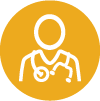When it comes to lumps and bumps that suddenly appear on your body, the good news is that it is nothing to worry about in most cases.
This is especially true when the lump or bump is soft, moves or changes form when you touch it or apply pressure, or grows larger and more painful when you are physically active and returns to normal when you rest. Despite these reassurances, we at United Hospital Center (UHC) encourage you to learn more about when a lump or bump warrants medical attention. We highlight the characteristics of three types of potentially concerning body lumps and bumps below.
Breast Lump
If you’re a woman who conducts monthly breast self-examinations, it is natural to feel worried when you feel a lump for the first time. After all, a new lump in the breast is often the most common sign of cancer and the first one that women discover. Some lumps are hard and painful while others do not cause any pain. The latter are more likely to be a benign breast condition such as a cyst.
We encourage you to schedule an appointment at UHC for any breast lump that concerns you. According to the National Breast Cancer Foundation, Inc., 40 percent of all new breast cancer diagnoses come after a woman first felt a lump herself. The earlier you intervene with breast cancer, the greater the chances of you making a full recovery.
UHC also encourages you to start monthly breast self-examinations if you have not done so yet. You can check your breasts for new lumps in one of the following three ways:
- Standing in front of a mirror: With your arms lying against your sides, look into the mirror to get a visual impression of your breasts. You should then raise both arms over your head and look for any noticeable changes in the dimpling or contouring of your breasts, swelling, or changes to either nipple. Finish the exam by placing your palms on your hips and flexing your chest muscles. Do not be alarmed if your right and left breasts don’t match perfectly, but check for puckering, dimpling, or other obvious changes, especially when they appear only on one side.
- When lying down: To start your exam, place a pillow under your right arm and shoulder directly behind your head. With the pads of your left hand, move around your right breast starting from the outside and working your way toward the nipple and armpit. Vary the pressure you apply to see if you can find any new lumps or bumps. You will also want to squeeze each nipple and check for unusual discharge
- While in the shower: Using the tips of your middle, pointer, and ring finger on one hand, move around the entire perimeter of each breast starting with the outside and moving toward the center. Do not forget to check under your armpit area as well. You should be feeling for hard lumps, hardened knots, or thickening of the breast tissue. These are symptoms that deserve immediate consideration.
Lymph Nodes
Lymph vessels and lymph nodes make up part of the body’s immune system. They have the important task of collecting bacteria, fluid, viruses, and waste material that are inside of the body’s tissues but outside of the bloodstream. The lymph vessels carry a type of clear watery fluid throughout the body while lymph nodes work to filter harmful substances from invading it. Every person has hundreds of lymph nodes throughout the body. They are movable lumps approximately the size of a pea most typically founds in the armpits, collarbone, groin, and neck.
Your lymph nodes swell in response to something as minor as a cold or due to mild infections. That is because they are being overtaken by dead cells. We encourage you to schedule an appointment for an evaluation at UHC if your lymph nodes swell to larger than pea-sized or it is noticeable to you for more than two weeks. Lymph cell abnormalities can indicate several types of cancer or they could be due to another cause. If you find something that concerns you, the only way to know for sure is to schedule a follow-up exam at UHC.
Skin Cysts
A skin cyst is a benign growth filled with pus, fluid, or another type of bodily liquid. Cysts can appear anywhere on your body and may look and feel like a small, hard pea. The most common causes of cyst formation include clogged oil glands, infections, and a growth that develops around a foreign body such as an earring or navel ring. They typically grow slowly over time, are not painful, and feel smooth when you touch them. Although most cysts disappear on their own without any treatment, others are persistent and you will need to schedule an appointment to have them drained.
These are just three common types of lumps or bumps that you may find worrisome. Please do not hesitate to contact us if you need guidance on other types or would like to request an appointment to investigate any type of suspicious lump or bump.
Please note, the information provided throughout this site is not intended or implied to be a substitute for professional medical advice, diagnosis or treatment. All content, including text, graphics, images, and video, on or available through this website is for general information purposes only. If you are experiencing related symptoms, please visit your doctor or call 9-1-1 in an emergency.

